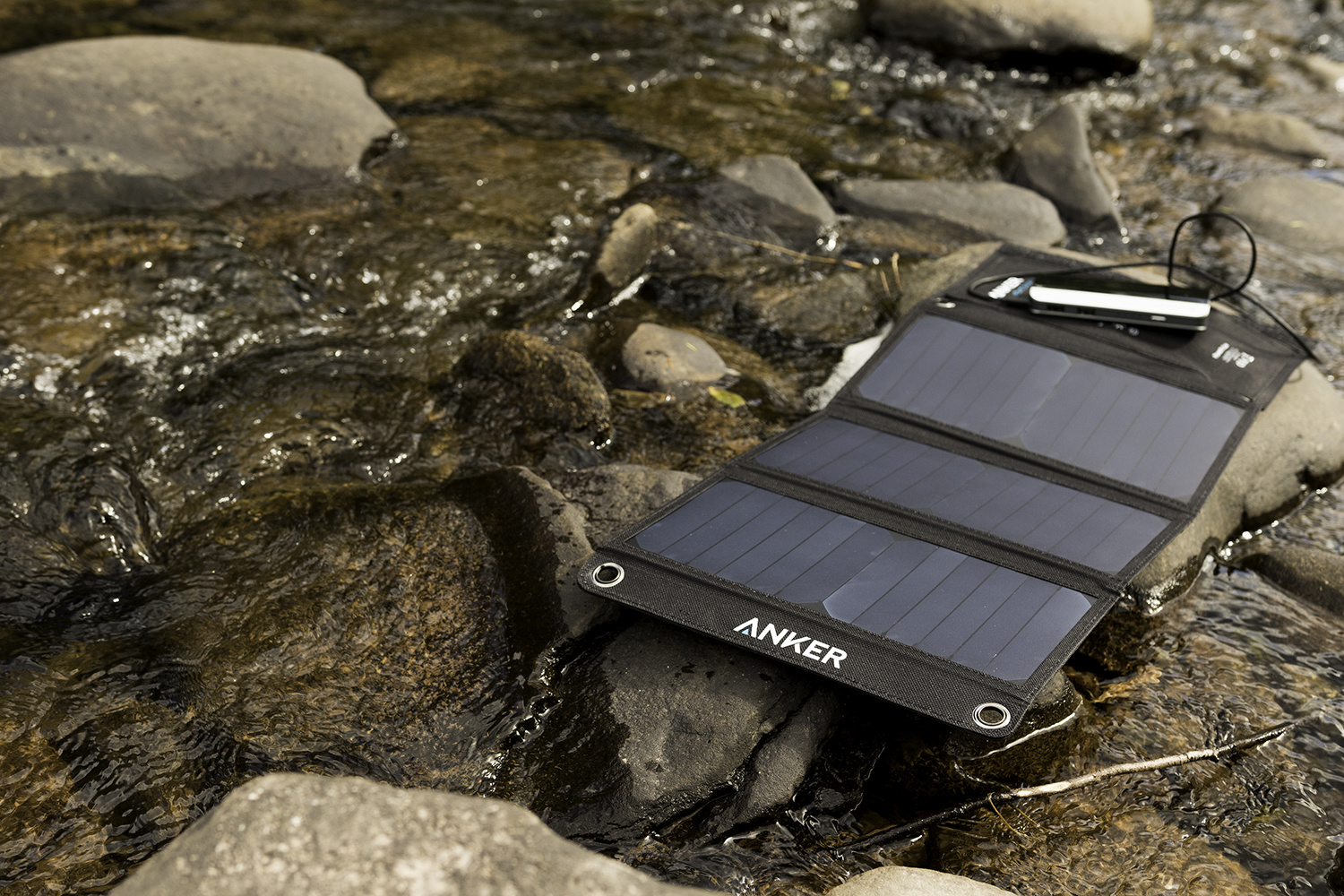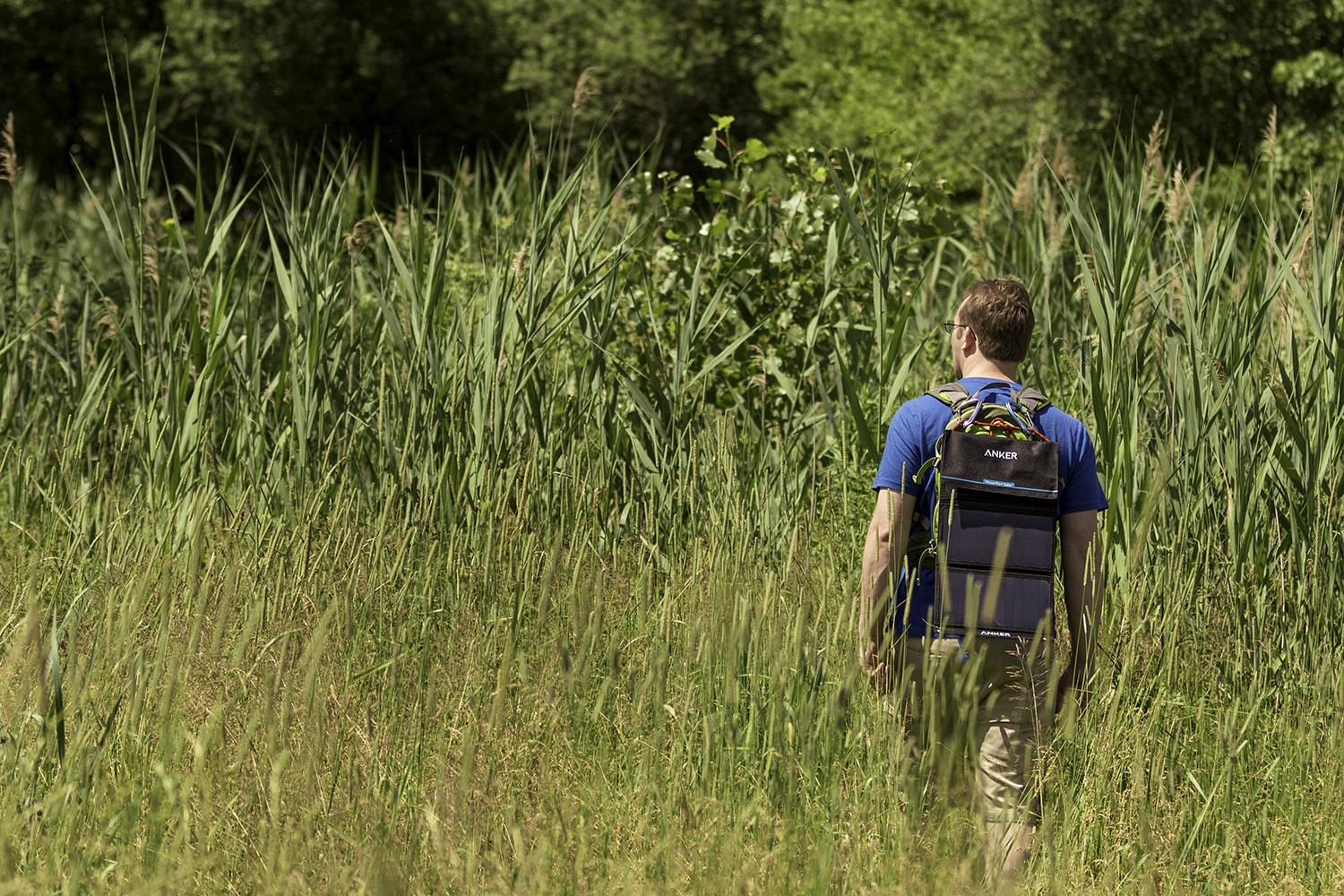Anker, a company known for their chargers, battery banks, and cables also produces a series of affordable and compact solar chargers. These devices, when combined with large mAh battery banks and various USB chargers, can be used to charge just about any electronic device, keeping a photographer up and running no matter how far they may travel.
We often take for granted how easily we can access power, plugging everything we own into a wall socket. I remember just a few years ago sitting in airports watching everyone fight over the few wall sockets available. Charging our devices, especially when traveling, had become essential and airports fell behind in offering a solution. Now it seems most places offer some sort of charging station and the drop in price and size of battery banks has made them easy to carry around. Yet the demand for power is ever growing.
As photographers, batteries are our greatest weakness. They power everything we use and each device or gadget needs a different one. On an average assignment I carry three different cameras now, then there are the countless devices that use AAs and AAAs. In addition to camera gear, I often travel with my Surface Pro 4, cell phone, and Nexus tablet. As an adventure photographer, I find myself in areas with little to no power charging opportunities, which often requires more gadgets that rely on yet more batteries. On my last trip to Africa, several of the villages had small general stores that sold charging time using portable solar panels. Everyone would drop their phones off in the morning and pick them up at the end of the day fully charged. This inspired me to look for an affordable and compact solution I could easily travel or hike with.
There have been plenty of companies selling solar panel charging kits for several years now but often if you're not putting together a large expedition or using them constantly the price didn't justify the benefit. I don’t need something to power a month in the Amazon. I want a backup for weekend trips into the mountains or for staying in small rural villages abroad. That's where the Anker 21W PowerPort Solar charger comes in. At roughly 11 x 6 inches, weighing only 15 ounces, and priced under $100, this is a device that won't break the bank or add a lot of bulk to my existing kit.
The 21w PowerPort is a great price to value item. It’s not going to charge my cell phone in 30 minutess like a wall plug will and I can't connect it to my laptop directly. However, it is quite efficient and with a few little tricks, I can charge every device I currently travel with on assignment.
Performance
Made up of three polymer-faced solar panels sewn into a polyester canvas material with a fourth section designed as a Velcro pocket, the entire device folds up to be about an inch thick. This makes it perfect for stashing in just about any bag that has a laptop/tablet compartment. It also turns out to fit perfectly in a small F-Stop Gear ICU right on top of everything in it. This worked out great for me since I often use this in my hiking pack.
Within the Velcro pouch, there are two USB charging ports with a small red LED to tell you there is power. Like Anker’s other chargers, it has PowerIQ technology which allows it to match your device's charging speed up to 2.4 amps each port or 3 amps overall. Of course, this is dependent on how much sun and at what angle it faces the sun. During testing, I wasn't able to track the exact amperage and I’m sure these numbers are ideal situations you will never be able to match, but in direct sunlight, I easily managed to repeat charging my phone in about an hour to an hour and a half. This quickly dropped both as the sun got lower in the sky and depending on how cloudy it was. Even in relatively poor conditions (full overcast), I managed to get about a 15–20 percent charge on my cell phone, which if you find yourself on a mountain in an emergency, that is more than enough.
There are also two metal grommets near the top and bottom that allow for hanging the panels in various ways to get better sun coverage. This actually is a pretty well thought out feature as I was able to mount and hang the panels in all kinds of places. It easily clipped onto the side of my tent and even off the back of my backpack, though the idea of hiking and charging on the go isn't really realistic. Leaving my pack in the Sun during a lunch break charged my battery bank about as much as an entire hour hiking in and out of tree cover. Having it set up this way did make it easy to just place my bag down in the sun during breaks and while shooting and get some extra juice. The plastic covered panels and polyester canvas gives it some water resistance, but I wouldn't chance it lasting long in a drizzle. I did leave it on the edge of a creek to charge while shooting for an hour where it did get splashed on a bit. No damage as far as I can tell.
The Best Way to Use a Solar Charger
If you want to get the most out of any solar charger the secret is to use battery banks. You can charge them throughout the day and then charge your various devices as needed. This also means you can charge just about any device since almost everything can be powered or charged via USB. I meant it when I said everything I use now can be charged via this solar charger because everything I currently use when traveling or in the outdoors can be powered and charged via USB. At first, I started simply finding several AA and AAA lithium battery chargers that used a USB connection. Then I started looking for a USB charger for my Canon DSLR batteries and sure enough, I found some. Now I could charge both my camera and speedlights via a large battery bank if I needed to. Of course, this wasn't enough for me so I look toward my Surface Pro 4. Could I actually charge this via a USB battery bank? It took some creative doing but the answer is yes, yes I could. With a little searching I was able to find USB chargers for just about any battery. Some newer cameras, specifically mirrorless ones, can even charge via USB through the camera, and with the rise of USB 3.0 several laptops can now charge via USB. All this makes for less cables to pack and more charging options.
Now as I mentioned above, this isn't going to power all your devices every day so you can live off the grid free of your electric bill. It will, however, give you a little extra juice for when you just have no other choice. I let the PowerPort sit all day in the sun with a 20,000 mAh battery bank that was completely drained connected while I was off hiking and shooting. In the roughly six hours I let it charge, I managed to get about a 70 percent charge. That's enough to charge the Surface more than one full charge or two Canon batteries. That would fully charge six AA batteries or my cell phone four times. I suspect If I took the time to re-position the charger throughout the day so it was always angled at the sun I could improve on these results.
What I Liked
- $60 price tag
- Compact folded up size
- Flexible and durable
- Two USB ports
What I Didn't Like
- Velcro pouch doesnt do much
- It could come with a couple mini carabiners
- Four panels might have made the amperage closer to stated specs
- Removable USB hub would make it thinner for packing
Conclusion
For the $60 price, the PowerPort does exactly what I wanted it to do. It’s made of durable material and the panels have plenty of flex to them. I wasn't careful with them in any way and have no doubt they will hold up to plenty of outdoor use. Anker is a reliable company and I've been using their products for years. I have never had an issue dealing with their customer support and trust that they will uphold the stated 18-month warranty. Its performance was well within my expectations. With any more affordable product you get what you pay for, but Anker always seems to walk that line of price to value. The stated charging specs are most likely not realistic and that seems pretty common with most solar panles. That being said My devices charged within a reasonable time and certainly better then had I had no charger at all. If you were to carry a couple of these on a trip you could easily keep all your equipment up and running. I’d say three of these stacked together would be roughly the size of a travel guide, so they really don't take up much room in your bag. Combined with a good quality battery bank, of which Anker also makes several, you won't miss that last bit of light on the landscape because your battery died.














Hey Michael, great post, especially for those like me looking for powering solutions now !
Can you also link to the USB chargers you talked about : for AA & AAA batteries, for Canon DSLR LP-E6 batteries and for the Surface Pro 4 and/or MacBook Pro.
Thank you !
I think I might try and turn that into an another article.
Great review. I've always wondered if this panels actually work. Sounds like they do.
If you need real power you are better off with 12v panels that connect to a small battery generator. unfortunately that's a minimum of 1k and a decent amount of weight. If you're going to be in rural areas for short periods or off the grid then you can do a lot with these in a pinch.
Heh, cool Anker backpack there. Because we all buy those, right :P
Your comment confuses me. The backpack has nothing to do with Anker or the article. Which makes me think you didn't actually read the article.
I like this idea! what usb charger did you find for the Canon batteries? Also check out www.goalzero.com/enphase to use a 30% discount at checkout! they have some great battery bank and solar charger options as well.
I would seriously consider buying one of these when I'm camping. Thanks
Peter